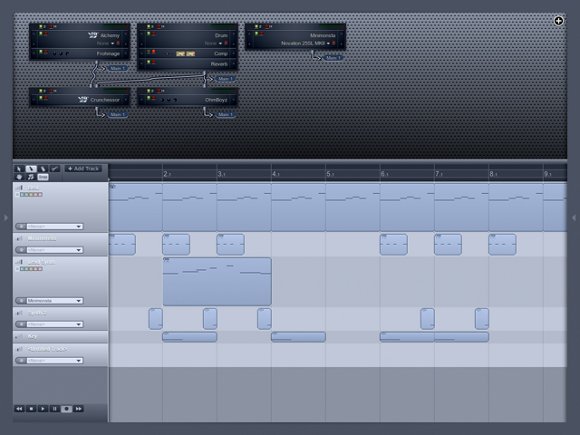
Surprise! Plug-in developer Ohm Force, known for their plug-ins (like effects Ohm Boys and Frohmage), today tease an upcoming collaborative host. It looks like the sort of thing Apple could have done, but hasn’t. There’s a GarageBand-style MIDI and audio editing pane, plus semi-modular routing of plug-ins on a pretty, graphical surface that resembles the “cheese grater” perforated aluminum of a Mac tower, and pop-up window palettes that resemble those we’ve seen on the “flattened UI” of the iPad.
The real feature here, though, is collaborative editing in the “cloud”: sessions are uploaded to a server, which in turn keeps track of versioning. (Actually, it’s quite unclear how that works collaboratively – this means you can “undo” from one version to another, but I can’t tell whether collaborators can try different “forks,” or if it’s all one set of linear changes.) The changes are “real-time,” though usually the trick to allowing international collaboration over the Internet is to make things delayed enough that everyone stays in sync.
There’s also an accompanying Web community for connecting with collaborators. Everything else about the product, however – more features, pricing, and specifics of how it all fits together – is as yet unknown. Mac and Windows are both supported, though – something Apple would not have done, most likely.
It’s an interesting idea, one I think we’ll see more frequently as connected applications grow in popularity. Among other options, Ableton had promised something like this with Share and then fell off the radar. Image-Line had a collaborative tool called Collab for its FL Studio, then abandoned it. The most significant competition comes from tools like Indaba. Indaba’s edge: by being powered by Web tech, you can do all your editing right in the browser; serious users can then keep using their host of choice and just bounce out audio. But while Indaba has an offline editor, too, the addition of plug-ins in Ohm Studio is a big change.
I do wonder with all of this, though: are we consigned to collaboration existing only in proprietary, integrated app-website combinations? Isn’t the whole lesson of the Web about open standards and platform-agnostic communication? Having said that, what would a more open tool look like – and what do people really want to do? (For instance, I wonder how hard it’d be to build a system that allowed open chat and transport control, with standards-based versioning and sharing, using the open-source DAW Ardour? See the post I’m … about to write … for the OSC end of this.) On the other hand, is the kind of integration Ohm Studio is offering necessary to make it all work together? (That last question we should be able to answer once this is in our hands and ready to try.)
I don’t wish to pre-judge Ohm Studio – on the contrary, I think this is a provocative product teaser that immediately raises some of these fundamental questions. So bravo, Ohm, for starting that conversation; I can’t wait to see what you’ve cooked up. And anything that gets artists collaborating is potentially a very good thing.
In the meantime, readers, it seems the most important question falls to you. Do you even want to collaborate with other artists? What would an ideal system look like for doing so? What features would you want? How would you want to work? Is real-time important, or do you prefer some time to sit back and think about how elements combine? When you collaborate now, how do you go about it?
Updated: Your closest bet at the moment is NINJAM, which is integrated with Reaper – a host various folks are using already – or on its own. Using compressed audio streams and latency compensation, it allows the exchange of any audio, and it works on Windows and Mac. But it doesn’t exchange MIDI data. (The site refers vaguely to this happening some time in the future, but I’m unsure of their progress.) And it doesn’t have integration with the Web community, though as readers note, you may want to work with people you get to know a bit first, anyway. Thanks to “PooPoo the Korruptah!” for the tip. (Hmm, no way for me to say that and not sound silly.)
More importantly – anyone out there using it? Or is it just easier to send files back and forth?